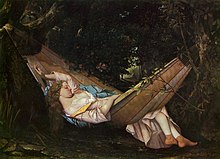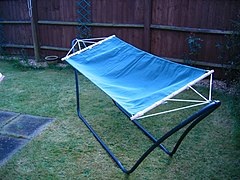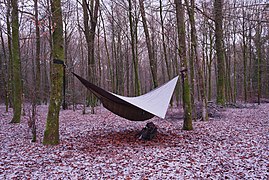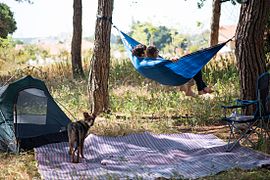Hammock


Ahammock,from Spanishhamaca,borrowed fromTaínoandArawakhamaka,is a sling made of fabric, rope, or netting, suspended between two or more points, used forswinging,sleeping,orresting.It normally consists of one or more cloth panels, or a woven network of twine or thin rope stretched with ropes between two firm anchor points such as trees or posts. Hammocks were developed by native inhabitants ofthe Americasfor sleeping, as well as theEnglish.[1]Later, they were used aboard ships by sailors to enable comfort and maximize available space, by explorers or soldiers travelling in wooded regions and eventually by parents in the early 1920s for containing babies just learning to crawl. Today they are popular around the world for relaxation; they are also used as a lightweightbedoncampingtrips. The hammock is often seen as a symbol ofsummer,leisure,relaxationandsimple, easy living.
Etymology
[edit]The wordhammockcomes, via Spanish, from aTaínocultureArawakanword meaning 'stretch of cloth' from the Arawak root-maka[2]whileha-indicated the action of hanging.[3]: 10, 46 TheAmerindianorigin of the word was often obscured in English-language sources from the late 18th century onward.Samuel Johnsonclaimed that it was ofSaxonorigin,[4]but his etymology was soon debunked.[5]Hamaka was meaningfully transformed into modern GermanHängematte,SwedishHängmattaand DutchHangmat,andcalquedfrom Swedish into Finnishriippumatto(all literallyhanging mat).
History
[edit]Europe
[edit]

Some 19th-century authors attributed the invention of the hammock to the Athenian politicianAlcibiades(d. 404 BC).[7]This was inferred fromPlutarch,who wrote that Alcibiades had hisgalleybed hung from ropes, but did not specifically describe it as a net or sling.[8]Other ancient writers mention the use of hanging beds to improve sleep or health without giving details on their mode of suspension.[9]
The 11th-centuryOld English Hexateuchshows the biblicalJoseph,promoted to the "secondchariot"of thepharaoh(that is second in command), in a simple type of vehicle, the body of which seems to be a cloth hammock.[6]The piece is suspended on two hooks attached to two opposite posts rising from thechassis.The hammock motif is repeated in the manuscript in a series of increasingly abstractminiatures,leaving it open to interpretation whether the artist had in mind a wheeled hammocklitteror a rudimentarycoachwith a flexible suspension.[10]
The hammock reappears in unequivocal form in anothermedieval Englishsource, theLuttrell Psalter(dated to c. 1330), where it has developed to a regular hanging bed.[1]The sling now ends in two ropebecketsthat anticipate the rings of the naval hammock.[1]Like the earliest knownnavalspecimen[11]the fabric iscanvas,not the netting the Spanish later encountered in theNew World.[1]The Dutch historian of technology André Sleeswyk argues that it may have been this English type that eventually spread through the European navies despite the wordhammocklater being adopted from the Americas:
It may be significant that in the first official mention of hammocks in theRoyal Navyof 1597 they are not referred to under that name, but as 'hanging cabbons or beddes'. The medieval canvas hammock may have been an English invention which was not known on the continent whenColumbusmadehis voyage.In the course of the seventeenth century its use spread to the navies ofWestern Europe,and eventually it was given the same name as theCaribbeanhammock of netting which came to Europe when Columbus returned.[1]
New World
[edit]
Spanish colonists noted the use of the hammock byNative Americans,particularly in theWest Indies,at the time of the Spanish conquest.[12]
Columbus, in the narrative of his first voyage, says: “A great many Indians in canoes came to the ship to-day for the purpose of bartering their cotton, andhamacas,or nets, in which they sleep.” He observed the widespread use of hammocks during his travels among the Taino people in the Bahamas.

Early hammocks were woven out of tree bark, and later this material was replaced bysisalfibers because it was more abundant. One of the reasons that hammocks became popular in Central and South America was their ability to provide safety from disease transmission, insect stings, or animal bites. By suspending their beds above ground, inhabitants were better protected from snakes, biting ants, and other harmful creatures.[13]

Gustave Courbet(1819–1877)

Naval
[edit]Around 1590, hammocks were adopted for use in sailing ships; theRoyal Navyformally adopted the sling hammock in 1597 when it ordered three hundred bolts ofcanvasfor "hanging cabbons or beddes".[11]Aboard ship, hammocks were regularly employed for sailors sleeping on the gun decks of warships, where limited space prevented the installation of permanentbunks.Since a slung hammock moves in concert with the motion of the vessel, the occupant is not at a risk of being thrown onto the deck (which may be 5 or 6 feet below) during swells or rough seas. Likewise, a hammock provides more comfortable sleep than a bunk or a berth while at sea since the sleeper always stays wellbalanced,irrespective of the motion of the vessel. Prior to the adoption of naval hammocks, sailors would often be injured or even killed as they fell off theirberthsor rolled on thedeckson heavy seas.[citation needed]The sides of traditional canvas naval hammocks wrap around the sleeper like acocoon,making an inadvertent fall virtually impossible.[original research?]If suitably packed, they could also be used as emergency flotation devices.[14] Many sailors in the Royal Navy, during the 1590s at least, used a spreader – a length of wood with a V cut in each end to engage the second hammock string on each side. The first string was set up more tightly than the others so that it raised a protective lip along each side to keep out drafts and prevent the sleeper being thrown out. A narrow mattress was also issued which protected the user from cold from below. In addition naval hammocks could be rolled tightly and stowed in an out of the way place or in nets along thegunwaleas additional protection during battle (as was the case during theage of sail). Many sailors became so accustomed to this way of sleeping that they brought their hammocks ashore with them on leave. The naval use of hammocks continued into the 20th century. DuringWorld War II,troopships sometimes employed hammocks for bothnaval ratingsandsoldiersin order to increase available space and troop carrying capacity. Many leisure sailors even today prefer hammocks over bunks because of better comfort in sleep while on the high seas.
Hammocks have also been employed on spacecraft in order to utilize available space when not sleeping or resting. During theApollo program,from Apollo 12 onwards, theLunar Modulewas equipped with hammocks for the commander and lunar module pilot to sleep in between moonwalks.[15]
Mexican and Maya hammocks
[edit]
InMexico,hammocks are made in villages surrounding the capital city of the Yucatán,Mérida,and are sold throughout the world as well as locally. Most accounts hold that they were not part ofClassic eraMaya civilization;they were said to have arrived in the Yucatán from the Caribbean fewer than two centuries before theSpanish conquest.In addition to bark andsisal,hammocks were constructed from various materials, includingpalmfronds. Quality of native and modern hammocks depends greatly on the quality of the material, thread, and the number of threads used. Mayan hammocks are made on aloomand are hand woven by men, women and children. Hammocks are so symbolically and culturally important for the Yucatecans that even the most humble of homes have hammock hooks in the walls.
El Salvador
[edit]
El Salvadoris a large producer and exporter of hammocks[original research?].The valley in which San Salvador City sits is dubbed "The Valley of the Hammocks" because theNative Americansused hammocks to "repel" constant earthquakes. Later, the colonizing Spaniards used the term as an allusion to earthquakes constantly rocking the valley like a hammock. Hammocks are a big part of Salvadoran culture and are often used for afternoon naps. It is completely socially acceptable to lie in a hammock all day in thisCentral Americancountry. Hammocks swing from doorways, inside living rooms, on porches, in outdoor courtyards, and from trees, in all social classes of Salvadoran homes from the most humble rural home to the most prestigious city hotel chains. In ruralEl Salvador,a family home may have multiple hammocks strung across the main room, for use as seating, as beds, or as sleep-swings for infants. The municipality of "Concepcion Quezaltepeque"celebrates its traditional Hammocks Festival, where artisans produce and sell hammocks, every year between the first and second weekend of November.
Venezuelan
[edit]In Venezuela entire villages raised their families in hammocks. During the first part of the 20th century, many scientists, adventurers, geologists and other non-native visitors to Central and South American jungles soon adopted the Venezuelan hammock design, which gave protection against scorpions and venomous snakes such as thefer de lance.The difficult jungle environments of South America encountered by Western explorers soon stimulated further development of the Venezuelan hammock for use in other tropical environments.
The Venezuelan hammock's panels were always made of breathable material, necessary to prevent the onset offungal infectionscaused by constant rain and high humidity.[16]Fine-wovensandfly nettingwas eventually added to provide more complete protection from mosquitoes, flies, and crawling insects, especially in regions notorious formalariaorscrewworminfestations. A waterproof top sheet or rainfly could be added to protect the occupant from drenching by heavy nighttime rains, along withdrip strings– short pieces of string tied to suspension lines — to prevent rainwater running from the tree trunk down the hammock cords to the hammock itself. A breathable false cotton (laternylon) bottom panel was frequently added to these jungle hammocks, allowing air to pass through while still preventing mosquito stings to the occupant.[16]
Jungle hammock
[edit]The Venezuelan hammock, as modified, eventually became known as ajungle hammock.Simply by wetting the hammock suspension ropes withinsecticidesorinsect repellent,the jungle hammock even gave protection against crawling insects withmandiblesthat could bite holes through the insect netting.
TheUnited States Armyeventually adopted their own version of the jungle hammock, complete with rain proof fly and sandfly netting for use by U.S. and Allied forces in tropical jungle regions such asBurmaduringWorld War II.[16]While at first reluctant to accept the idea of its men sleeping in hammocks, theUnited States Marine Corpslater employed jungle hammocks inNew Britain[17]and laterPacific island campaignswhere heavy rain and insects were prevalent; concerns over injuries frommachine gunandartilleryfire were overcome by first digging aslit trench,then staking the hammock's support lines to suspend the hammock beneath ground level.[18]
Later U.S. Army hammocks issued during theVietnam War,such as the M1966 Jungle Hammock, were mistakenly fitted with waterproof bottom panels, which often became filled with water overnight.[19]On the other side,North Vietnamese Army(NVA) andViet Cong(VC) forces regularly employed jungle hammocks fabricated from scavenged or captured USparachutecloth and shroud lines. Hung well off jungle trails, the hammocks kept down the incidence of disease and illness, which NVA commanders generally regarded as a greater threat thanshrapnelinjuries caused by sleeping above ground.[20]
After theVietnam War,the use of hammocks has become popular in Vietnam among the civilians, as the civilians learned how to make hammocks and sleep in them from the American soldiers. Many used parachutes were recycled into hammocks, and also local styles have emerged.[21]
Indian
[edit]
Ceiling mounted hammocks for babies are traditional to southIndia.The textile used is the woven 5 meterSari,which is long enough to be hung high, yet reach low enough to be safe for toddlers. The light material allows perspiration and cooling in the hot climate native to this region.
Lunar crewed missions
[edit]
The first two men to walk on the Moon,Apollo 11astronautsNeil ArmstrongandBuzz Aldrin,spent their rest periods on theApollolunar modulefloor and reported being too cold to sleep comfortably.
From the missionApollo 12until thelast Apollo lunar mission,hammocks designed to attach to the interior of the lunar module ascent stage were provided. They helped reduce the cooling effects of contact with the cabin floor as well as a softer support. They enabled astronauts from the last missions to spend complete nights of sleep on the Moon.[22]
Current
[edit]Usage
[edit]There are currently a wide variety of hammocks available. There are hammocks that are designed specifically forbackpackingand includemosquitonetting along with pockets for nighttime storage. There are hammocks made out of thin and lightweight material which makes them ideal for taking on daytrips. Other hammocks include self-standingmetalorwoodstructures that support the hammock. Given that hammocks are commonly similar lengths to accommodate for an average adult's height, most hammock stands are universal in design, typically featuring a spreader bar that runs along the ground, feet for stability at each end, and a diagonal arm at each end to provide two hanging points.
-
Bridge hammock with bugnet
-
Hammock on a frame in a residential backyard
-
Crochetedhammock
-
Nylon hammock,
residential backyard. -
Hammock with tarp and underquilt
-
Hammocks,
Amazon River island,
Brazil.
Hammocks are very popular in theBrazilian northeast region,but not only as sleeping devices: in the poorest areas of thesertão,if there is not acemeteryin a settlement, hammocks may be used to carry the dead to a locale where there is one; also, they frequently serve as a low-cost alternative tocoffins.This custom inspiredCandido Portinari's 1944 paintingEnterro na Rede( "burial in the hammock" ).[23]Traditionally thesailorswho have died at sea wereburied at seain their hammocks.
Medical research suggests the gentle rocking motion of the hammock allows users to fall asleep faster and sleep more deeply compared to a traditional, stationary mattress.[24]
Styles
[edit]Current popular hammock styles include the spreader-bar, Mayan, Brazilian, naval, Nicaraguan, Venezuelan (jungle), and travel hammocks. Each style is distinctive and has its own set of advantages and disadvantages. Many hammocks come in a variety of colors, patterns, and sizes ranging from a one-person (250 – 350 lbs / 110 – 160 kg) to two or three person (400 lbs – 600 lbs / 180 – 270 kg). Common dimensions for unslung hammocks fall in a range between 3'/0.9m to 14'/4.2m across and 6'/1.8m to 11'/3.3m long.
The spreader-bar hammock is easily recognized by wooden or metal bars at the head and foot of the hammock, spreading its width and allowing for easy access for casual use, such as in a backyard. Unfortunately, the spreader bars also make the hammock unsteady since the metacenter of the hammock when sleeping is very high. This style is generally considered less stable and less comfortable for sleeping than other styles. A subset of this style is the single-spreader bar hammock, which uses a spreader bar on only one end and is much more stable. A variation of the single-spreader bar hammock has three attachment points, one at each corner of the spreader bar and one at the non-spreader bar end, and is nearly untippable.
While the various styles of hammocks available today are similar in form, they differ significantly in materials, purpose, and construction.
Mayan and Nicaraguan hammocks are made from eithercottonor nylon string that is woven to form a supportive net. Mayan Hammocks have a looser weave than Nicaraguan hammocks, and the supportiveness of the hammock "bed" depends on the number of strings and quality of the weave.
Brazilian hammocks are made from cotton fabric and usually more durable than the string varieties. While Mayan and Nicaraguan hammocks are considered by some to have the potential to be more comfortable, the Brazilian hammock's comfort is less dependent on its construction and therefore less likely to vary as highly from manufacturer to manufacturer.
Naval hammocks are usually made from canvas or strong cotton. They are intended to be durable and stand well the hardships of shipboard use. They usually are simple and undecorated but robust. Venezuelan or jungle hammocks made today are generally of breathable nylon or polyester, and use dacron or similar non-stretch suspension lines. They are "inline" hammocks; like the canvas naval hammocks of old, the occupant sleeps along the length of the hammock, rather than across it. With their breathable false bottoms, drip strings, sandfly netting, and optional rainfly, they are one of the most secure hammocks against not only water entry, but also insect stings or bites.

Travel orcamping hammocksare popular amongleave no traceand ultra-light campers, hikers, and sailing enthusiasts for their reduced impact on the environment and their lightness and lack of bulk compared to tents.[25]They are typically made of sturdy nylon parachute fabric which may useripstoptechniques to improve durability. Some hammocks feature a mosquito net and storage pockets. Some types offer a ridgeline to make set up easier, and may also include a slit for entry through the bottom of the hammock. Special webbing straps (called "treehuggers" ) are used to loop around trees in order to create attachment points for the hammock.
Set-up and use
[edit]For non spreader-bar styles, the way they are hung is critical for comfort. Generally, a higher attachment point is preferred as well as sufficient length between points, though these two dimensions can be adjusted to compensate for a lack in one or the other. The optimal angle of the attaching lines to the post / wall / tree is usually about 30 degrees.[26]Hammocks can be attached to the anchor points using a variety of suspension systems, including ropes and webbing straps.[27]
Though one can lie in a hammock lengthwise or across its width, most hammocks are best used with a diagonal position, as it provides the most room and support. Users with back and joint pains often report some relief from these problems when sleeping in a hammock in this manner.

Gallery
[edit]-
Nylon ripstop
camping hammock -
Hammock aboard theGrand Turk
-
Hammock on a tropical beach
-
Baby hammock,Pangkor
-
Bear in a hammock
Kuangsi sanctuary, Laos
See also
[edit]References
[edit]- ^abcdefSleeswyk 1990,p. 362
- ^Aĭkhenvald, Alexandra (2012).Languages of the Amazon.Oxford University Press. p. 64.ISBN9780199593569.
- ^Nin, Leonardo W. (2020).Language of the Voiceless: Traces of Taino Language, Food, and Culture in the Americas From 1492 to the Present(Master's thesis).Harvard Extension School,Harvard University.
- ^Samuel Johnson (1785)A Dictionary of the English Language
- ^Arthur Broughton (1797)The History, Civil and Commercial, of the British Colonies in the West Indies
- ^abWhite 1970,pp. 428–431
- ^Thomas Dudley Fosbroke(1825),Encyclopædia of Antiquities, and Elements of Archaeology, Classical and Medieval,Vol. 1, London, p. 270
- ^Plutarch,Life of Alcibiades,16.1
- ^Pliny the Elder,The Natural History,26.8;Aulus Cornelius Celsus,De Medicina,3.18
- ^Sleeswyk 1990,pp. 361–362 leans towards the identification as a proper hammock,White 1970,pp. 428–431 argues for the latter.
- ^abBlomfield 1911,p. 144
- ^Bartolomé de las Casas (1542)The Destruction of the Indies
- ^Encyclopædia Britannica(1823)
- ^"Chief Petty Officer Victor Merry, Boy Seaman in battleships and destroyers in the Second World War – obituary".Daily Telegraph.9 November 2018.
- ^"Hammock, Lunar Module".National Air and Space Museum.2016-03-17. Archived fromthe originalon 2017-09-22.Retrieved2017-09-22.
- ^abcKearny, Cresson H. (Major),Jungle Snafus...And Remedies,Oregon Institute (1996), pp. 240–248
- ^Leckie, Robert,Helmet For My Pillow,Bantam (1979), pp. 230, 237–238
- ^Kearny, Cresson H. (Major),Jungle Snafus...And Remedies,Oregon Institute (1996), pp. 244–254, 261
- ^Kearny, Cresson H. (Major),Jungle Snafus...And Remedies,Oregon Institute (1996), pp. 256–257
- ^Kearny, Cresson H. (Major),Jungle Snafus...And Remedies,Oregon Institute (1996), pp. 252–253
- ^"THE POPULARITY OF USING HAMMOCKS NOWADAYS IN VIETNAM IN THE PAST".bitraexport.vn(in Vietnamese).Retrieved2024-08-28.
- ^"Hammock, Lunar Module".
- ^"UOL – O melhor conteúdo".uol.br.Archived fromthe originalon 2007-11-12.
- ^"Hammocks Help You Sleep".WebMD.
- ^Parks, Bob (2013-07-02)."What Are the Best Ultralight Hammocks?".Outside Online.Retrieved2019-11-17.
- ^Derek Hansen: The ultimate hang, page 14,ISBN9781466263680
- ^Derek Hansen: The ultimate hang, page 291,ISBN9781466263680
Sources
[edit]- Blomfield, R. Massie (1911), "Hammocks and their Accessories",The Mariner's Mirror,1(5): 144–147,doi:10.1080/00253359.1911.10654498
- Sleeswyk, André W. (1990), "The Origin of the Hammock",The Mariner's Mirror,76(4): 361–362
- White, Lynn(1970), "The Origins of the Coach",Proceedings of the American Philosophical Society,114(6): 423–431












